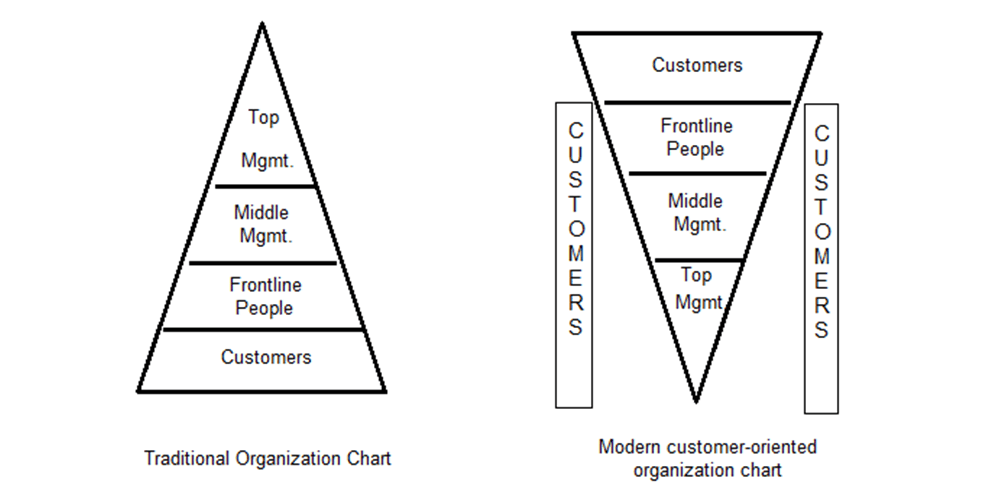Customer value is the customer’s evaluation of the difference between all the benefits and all the costs of a market offering relative to those of competing offers (Kotler et al. 2008). Image adapted from Kotler and Keller (2016).
In traditional organization, the business model adopted was “top management” at the top and customers at the bottom. However, that is now considered an obsolete model.
A company’s only true “profit center” is now considered a modern customer-oriented organization. Some companies have been founded on the customer-on-top business model, and customer advocacy has been their strategy, giving them a competitive advantage.
Businesses today operate in a customer-driven market where they are focused on improving not just the product/service, but the perceived value.
From internal quality assurance to external customer satisfaction, the emphasis is on improving customer value as that is the reason why customers choose a product. Customers not only look at the entire range of product, but they also look at the services and intangibles, and image and brand reputation of a company.
Related: Understanding the Customer Value Chain
Customer value drives improvements in various business functions, including Supply Chain, nowadays and most Supply Chain Management (SCM) strategies are focused on maximizing customer value.
Related: SERVQUAL Model of Service Quality
Customer Perceived Value (CPV)
Total customer benefit is the perceived monetary value of the bundle of economic, functional, and psychological benefits customers expect from a given market offering because of the product, service, people, and image.
Total customer cost is the perceived bundle of costs customers expect to incur in evaluating, obtaining, using, and disposing of the given market offering, including monetary, time, energy, and psychological costs.
Managers conduct a customer value analysis to reveal the company’s strengths and weaknesses relative to those of various competitors.
The steps in this analysis are:
- Identify the major attributes and benefits that customers value. These attributes and benefits should be defined broadly to encompass all the inputs to customers’ decisions.
- Assess the quantitative importance of the different attributes and benefits. Customers are asked to rate the importance of different attributes and benefits.
- Assess the company’s and competitors’ performances on the different customer values against their rated importance.
- Customers describe where they see the company’s and competitors’ performances on each attribute and benefit.
- Examine how customers in a specific segment rate the company’s performance against a specific major competitor on an individual attribute or benefit basis. If the company’s offer exceeds the competitor’s offer on all important attributes and benefits, the company can charge a higher price (thereby earning higher profits), or it can charge the same price and gain more market share.
- Monitor customer values over time. The company must periodically redo its studies of customer values and competitors’ standings as the economy, technology, and product features change.
Kotler, P. and Keller, K.L., 2016. Marketing management (15th global ed.). England: Pearson, pp.803-829.
BATheories.com is managed by a group of educators from Mumbai. We also manage the website StudyMumbai.com. Our panel includes experienced professionals and lecturers with a background in management. BATheories is where we talk about the various business theories and models for BA (Business Administration) students.
